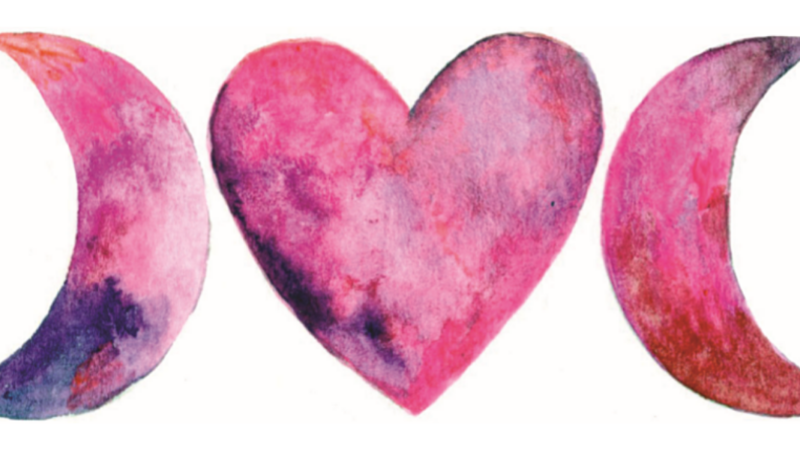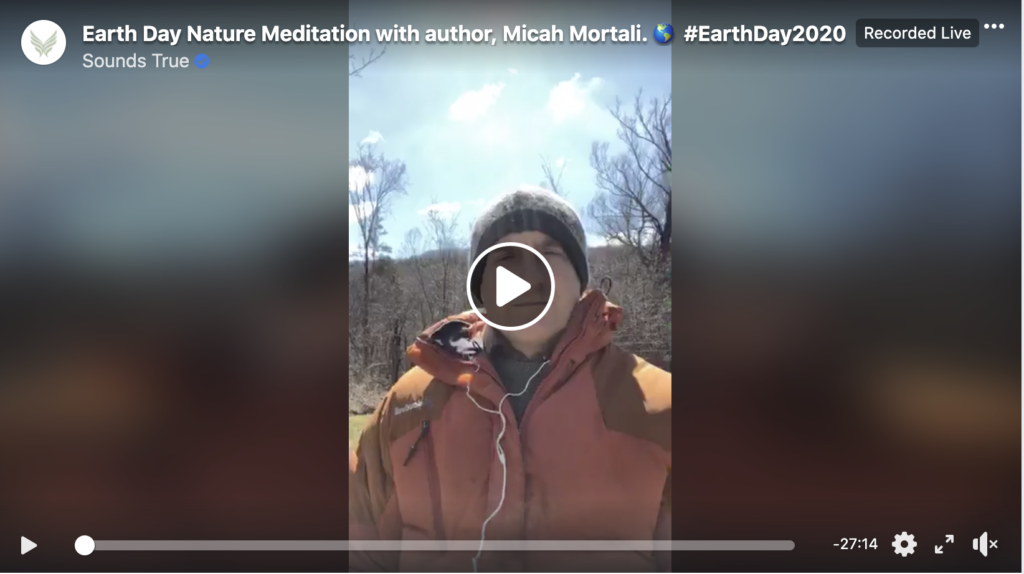The Heart Center Meditation
One of the most important aspects of awakening, says Dr. Ann Marie Chiasson, is the opening of the heart. The heart is a floodgate which, when open, enables the world’s great mystical teachings and realizations to pour through.
Here, Ann Marie guides you through a short, heart-centering meditation, which you can practice daily, or anytime you wish to access the mystery and intelligence that is your own heart.
When Pain is the Doorway – with Pema Chödrön
Friends, I wanted to let you know about a new audio program we just released from our dear friend Pema Chödrön. In my experience, Pema has a real gift at skillfully guiding a person into the heart of their immediate embodied experience, which is often right into those scary places that are so easily avoided. This work of embodied immediacy is so simple, really, yet not easy; in fact it actually requires everything we have… and a bit more.
Listen to a free audio sample/ learn more about our lovely new audio program with Pema, entitled When Pain is the Doorway.
What if the full sense of our aliveness were only to be found amidst our most challenging times and difficult experiences? In pain and crisis, teaches Pema, there lies a hidden doorway to freedom that appears to us only when we’re sure that there is no way out.
In these intimate audio learning sessions, Pema helps us distinguish the triggers or external events that we blame for our suffering from the deeper habitual patterns that feed our anger, fear, or sadness. From this understanding, we learn how to free ourselves from our propensity to suffer through the transformative awareness of impermanence—the dynamic and ever-shifting nature of both joy and suffering, self and selflessness—and the absolute and eternal flow from which all of it arises.
What is causing my pain? What will happen if I simply lean in, keep company with it, hold it with tenderness? Moment by moment, Pema supports and encourages listeners to bring an openhearted sense of curiosity and welcoming to our apparently impossible situations or unbearable relationships—to discover the deeper freedom available just beneath the surface.
For those experiencing emotional crisis, When Pain Is the Doorway provides expert guidance to help us stop, stay present, and enter into a more welcoming, spacious place of being that is our true home.

DIY Rose Essence and Heart Breathing Ritual
The heart chakra is the central integrating chamber of the chakra system. Through the healing power of love, all things eventually find their way to connection and wholeness.
ANODEA JUDITH
Heart Medicine Rituals
The greatest lesson I have learned so far is to exist within my heart. This is a lifelong practice for me because, like many, I was not taught to inhabit my heart space. On a physical level, the general collective is not doing so well in our hearts. This is evidenced by the stark reality that heart disease is the leading cause of death worldwide. This high incidence of disease points to a deeper situation of the heart, but in order to be open to the possibility that more profound heart healing is necessary and possible, we must open our minds to a more metaphysical or energetic interpretation of what the heart is and what it does. Ancestrally, the heart held a much higher evolutionary significance, and as our consciousness split, we moved from inhabiting our hearts to glorifying our minds. Perhaps this disconnect can illuminate some clues for us to consider to reclaim more balance within our hearts, ourselves, and our world.
Vibrationally, the heart contains the strongest electromagnetic field of any organ in the body. Transference of heart energy can occur in close proximity with another human or animal; and if you apply the theories of quantum entanglement and wave function collapse, transference of heart energy can resonate beyond space or time. Plants and the elements, too, can have a positive entrainment effect on the heart, reiterating the interconnectedness of all life and the organic balance nature engenders. In both traditional Chinese and Tibetan medicines, the heart is the mind. In TCM, grief is stored in the lungs and closely related to the heart. The Hopi defined harmony as one’s heartbeat in resonance with others and the Earth.
Our liberation is tied to the heart. The cost of liberation is unique to every person and is cosmically linked to each of us. The price of liberation varies for each individual, but we are given choices: in what we think, what we feel, what we believe, how we want to be. The inability to see choice is the unconsciousness of the fear-based toxic masculine that seeks to keep us disconnected and disempowered.
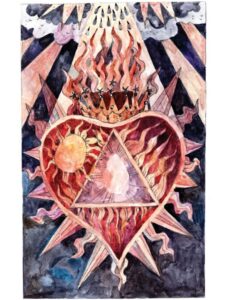
Our liberation depends largely on our ability to love unconditionally. Unconditional love means loving without circumstance or codependence. This can take different forms, from exiting a toxic relationship to taking more care of yourself. And it doesn’t stop there. If you want to get really free, you have to love yourself no matter what, and love all beings no matter what. Tall order? Yes. Impossible? No! While humans are conditioned to be in separation, plants (and animals) hold only unconditional love for all life. There are people on this Earth who radiate unconditional love, and when you are in their company, your heart is completely relaxed and open. For instance, my heart feels completely free when I am with people and animals who love me unconditionally. My heart also feels free in this way when I am in nature. Can you think of anyone who loves you unconditionally? Or perhaps it’s easier to think of an animal or pet? What if you loved yourself and everyone like that? What if you loved all your uncomfortable parts, illnesses, and neuroses like that?
EXERCISE: Making a Rose Essence and Heart Breathing Exercise
There are a few plants whose application is almost universal, and the rose is one such flower. Roses hold the frequency of unconditional love and have an affinity for the heart chakra. This ritual works best with either a wild growing or organically cultivated rose; it can be any species within the Rosa genus. Some of the lower vibratory states that can be addressed with rose include grief, loss, heartbreak, depression, and panic.
This ritual is very simple. You’re going to combine the process for making your own medicine (see a simple how-to video here) using the rose of your choice, with the heart breathing exercise that follows. The heart breathing can be done while the flowers are in the water, working their magic. The heart energy you engage during the medicine-making process will become part of the energetic signature of your flower essence. After you bottle it and make the dosage bottle, take a few drops and see what you notice around your heart. Be sure to notate your findings. You now have a rose flower essence for your apothecary whenever you or someone else needs it.
HEART BREATHING RITUAL
After you have placed the flowers in the bowl with the water, sit comfortably on the ground, if possible. Close your eyes or set your gaze low. Place both hands over your heart and begin to breathe into the heart space. Visualize the rose you are working with. Notice how the breath moves in and out of the heart—not forcing the air, just allowing it to move. See if you can sense into how the heart is feeling—in the front, in the back, all sides. Be sure to breathe into the back of the heart space. Notice how the heart feels when you place your awareness on it. See if it’s okay to allow whatever is arising, witnessing without judgment.
After a few minutes, begin to bring the heart back into a neutral position. Thank your heart and the spirit of rose for sharing with you. Feel your body making contact with the Earth, deepen the breath, and slowly open your eyes.
The video on how to make your own flower essence medicine can be found here.
This is an excerpt from The Bloom Book: A Flower Essence Guide to Cosmic Balance by Heidi Smith.
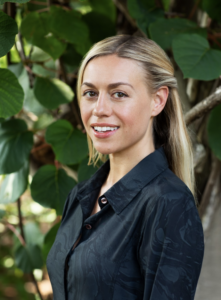
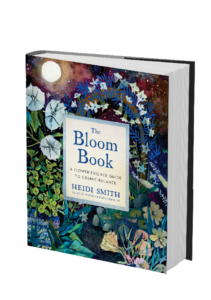
Heidi Smith, MA, RH (AHG), is a psychosomatic therapist, registered herbalist, and flower essence practitioner. Within her private practice, Moon & Bloom, Heidi works collaboratively with her clients to empower greater balance, actualization, and soul-level
healing within themselves. She is passionate about engaging both the spiritual and scientific dimensions of the plant kingdom, and sees plant medicine and ritual as radical ways to promote individual, collective, and planetary healing. She lives in Brooklyn, New York, with her partner and two cats. For more, visit moonandbloom.com.
Learn More
Sounds True | Amazon | Barnes & Noble | Bookshop
Nature Meditation by a Window
With many people home-bound, we may need to get creative in seeking ways to connect with the natural world. Sitting by an open window is one excellent practice for connecting with the outdoors, and it can be a powerful form of nature meditation as well.
“What is life? It is the flash of a firefly in the night. It is the breath of a buffalo in the wintertime. It is the little shadow which runs across the grass and loses itself in the sunset.”
Crowfoot, Orator of the Blackfoot Confederacy
- Find a comfortable seat by an open window that looks outdoors.
- Morning, during the dawn chorus when birds are most active, can be a perfect time to enjoy your morning coffee or tea as you observe a new day emerge.
- Set an intention to stay present, letting go of thoughts or stories in your mind as they arise, and instead focusing your attention on whatever is fascinating in your environment.
- Sit for at least 15-30 minutes if you can. Practice regularly to help alleviate stress, increase your sense of connection with your local environment, and awaken your senses.
Find more practices for connecting to nature in Rewilding: Meditations, Practices, and Skills for Awakening in Nature by Micah Mortali.
Read Rewilding today!
Sounds True | Amazon | Barnes&Noble | Bookshop
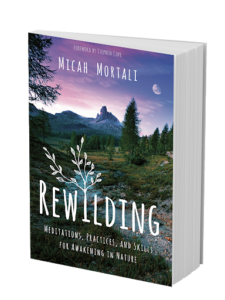
How Do You Shine Bright? Managing Your Energy Ecosystem™
When you hear the phrase “shining bright,” what does it evoke for you? Does it mean being yourself? Is it radiance, openness, or casting your energy outward toward others? Is it being the center of attention?
For me, shining bright is about sustainable personal energy, understanding your unique spiritual makeup or energetic personality archetype. It’s about managing your energy ecosystem. It’s also about keeping the balance of what’s “coming in” and what’s “going out,” as all healthy systems do.
One of the ways I feel my “brightest” is when I’m in nature, especially in the little jungle of my backyard. As I write this, a rabbit is relentlessly distracting me by flashing its ears in my line of sight, stretching up to grab some leaves, ducking down into the ivy. Observing and immersing myself in nature keeps my energy ecosystem healthy. It helps me see the bigger picture of the earth’s systems and appreciate the extraordinary beauty that exists in our seemingly ordinary spaces. I breathe differently and feel lighter when I’m watching the creatures and plants outside.
Rabbits don’t do it for you? You may need the bright lights of the stage, deep long meaningful conversations, sweaty workouts, or something else. It’s a combination of things that blend to create ideal self-care habits, big and small routines that honor who we naturally are and help us be our most radiant.
It’s hard to shine bright when you’re burned out. Many of us are overwhelmed, facing disasters of all kinds. Even if we’re not experiencing direct trauma, the world feels chaotic. That can make it easier for us to spin out of control a little too and neglect healthy habits. Maybe, like me, you love and are rejuvenated by time in nature, but feel you must travel to far-off places to find the wild and that’s not possible right now. Maybe you’ve struggled to find a practice that suits who you are and fits into your life. Maybe you feel the experiences of those around you so keenly in your body that it’s hard to distinguish your own emotions and needs.
We’re vulnerable to burnout when we get overwhelmed and depleted when we become cynical and feel negative and ineffective about our work. We start to distance ourselves from others and detach from ourselves, our needs, and what it takes to be healthy and happy.
I have two resources to help, one is available now, and one will be available soon.
Even if you only have a few moments, making time to meditate or journey regularly can help avoid burnout. Shamanism for Every Day: 365 Journeys is a daily guide for reconnection. No pressure, not another to-do list item, but a gentle way to engage your inner wisdom and the support of the spirits around you to stay healthy. Shining Bright Without Burning Out: Spiritual Tools for Creating Healthy Energetic Boundaries in an Overconnected World is an audio course that will help you step by step to manage what comes into your energy ecosystem and what goes out. We’ll reframe how you engage the world in order to stay compassionate and present, without losing your spark or burning out, so that you can shine bright and enjoy your time here on this beautiful earth.
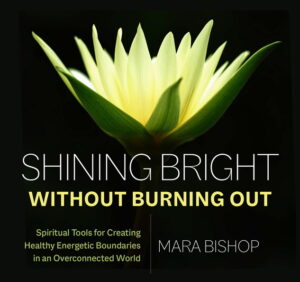 Preorder Shining Bright Without Burning Out now!
Preorder Shining Bright Without Burning Out now!
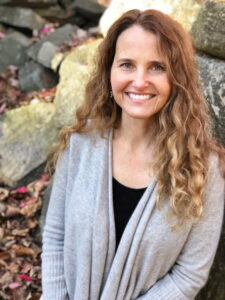
Mara Bishop has over 25 years of experience helping people find spiritual health and well-being. Her Personal Evolution Counseling™ method blends shamanism, psychology, intuition, energy healing, and nature-based practices. She lives in Durham, NC with a beloved family of people, animals, and plants.
More information about Mara is at www.WholeSpirit.com
The Basics of Natural Awareness 101: Broadening Attention

There are three deliberate mental shifts you can make during classical mindfulness meditation that can help point you toward natural awareness: relaxing effort, broadening attention, and dropping objects.
If you have not read the first step yet, you can find Relaxing Effort on our blog.
Broadening Attention
Your attention can be very narrowly focused or broadly focused. It can also be somewhere in between. You might notice the differences because you naturally adjust the breadth of your attention in life all the time. You are driving your car, and you focus first on your dashboard, and then you automatically shift to a wider peripheral sense of the road in front of you. You are talking with a friend, and you focus on her face, then shift to her whole body, and then notice the room in which you both are sitting.
We can think of the mechanism of attention as being like a camera. Sometimes you use a telescopic lens in order to focus on something quite narrow—maybe taking a close-up of a flower, seeing the intricacies of the stem and petals in detail. Usually we take midrange photos—of our kids, friends at the game, or whatever the selfie du jour is—employing a lens that is not too narrowly focused, but open in a general way. The far end of the spectrum would be when we use a panoramic lens to take an elongated, comprehensive photo of, let’s say, the Grand Canyon.
When we meditate, we can apply a narrow or panoramic attention. An example of using a narrow focus would be attending primarily to your breath (or any single object of focus). The panoramic attention would be when our attention is wide open—when we notice many things going on or just have a general wide view. When, for example, we listen to sounds coming from all directions surrounding us, this is a panoramic attention, or wide focus.
We can even apply an attention in meditation that’s somewhere in between these two. A somewhere-in-between attention might be when a few things are going on and our attention can encompass them, either simultaneously or consecutively. Our lower back is achy, and we’re trying to attend to the pain. And then perhaps we move our attention to a global sense of our body or to a part of our body that feels okay at the moment (typically our hands or feet), so that we’re not overwhelmed by the pain. (This is a helpful recommendation if you’re experiencing pain in meditation.)
Broad, panoramic attention tends to be the type of attention present when we do natural awareness practice. Because most of us gravitate toward a focused attention both in meditation and in daily life, opening up panoramically can actually invite in natural awareness. It counteracts our usual forward-focus tendencies and allows our minds to rest and reset, kind of like a brain vacation.
But broad or panoramic attention does not equal natural awareness; instead, shifting into broad attention will point us in the direction of natural awareness. That’s why many of the glimpse practices in this book focus on broadening our attention. Sometimes as we practice broadening our attention, we find ourselves thoroughly and completely aware, which is close to how I defined natural awareness earlier in the book. And it is also possible to have natural awareness without noticing broadly.
Try broadening your attention right now.
Close your eyes if that is comfortable to you. Start by narrowing your attention to a single area of focus in your body—your abdomen, chest, or nostrils. Try to keep this narrow focus for a few minutes.
Now begin to listen to the sounds around you. Start with sounds nearby, but then listen with an expansive ear. How far away are the sounds you can hear? Listen to the sound that is farthest out. Try this approach to listening for a minute or two.
Now notice your whole body. Can you fully feel your body seated here? Relax and unclench your belly. Imagine you could expand that sense of your body, feeling your body moving out in all directions, including above and below. Try being aware of your expanded body for another minute.
Finally, open your eyes and let your gaze become peripheral—wide open, noticing the space around you. Let your eyes be soft, but take in an expansive view. Keep your stomach relaxed. Explore this expanded view for a few minutes, resting here, and then notice what happens to your awareness.
Continue reading the next step, Dropping Objects, or read the previous step Relaxing Effort.
This is excerpted from The Little Book of Being: Practices and Guidance for Uncovering Your Natural Awareness by Diana Winston.
 Diana Winston is the director of Mindfulness Education at UCLA Semel Institute’s Mindful Awareness Research Center (MARC) and the coauthor, with Dr. Susan
Diana Winston is the director of Mindfulness Education at UCLA Semel Institute’s Mindful Awareness Research Center (MARC) and the coauthor, with Dr. Susan
Smalley, of Fully Present: The Science, Art, and Practice of Mindfulness. She is a well‑known teacher and speaker who brings mindful awareness practices to the general public to promote health and well‑being. Called by the LA Times “one of the nation’s best‑known teachers of mindfulness,” she has taught mindfulness since 1993 in a variety of settings, including hospitals, universities, corporations, nonprofits, schools in the US and Asia, and online. She developed the evidence‑based Mindful Awareness Practices (MAPS) curriculum and the Training in Mindfulness Facilitation, which trains mindfulness teachers worldwide.
Her work has been mentioned or she has been quoted in the New York Times; O, The Oprah Magazine; Newsweek; the Los Angeles Times; Allure; Women’s Health; and in a variety of magazines, books, and journals. She is also the author of Wide Awake: A Buddhist Guide for Teens, the audio program Mindful Meditations, and has published numerous articles on mindfulness. Diana is a member of the Teacher’s Council at Spirit Rock Meditation Center in Northern California. She has been practicing mindfulness meditation since 1989, including a year as a Buddhist nun in Burma. Currently, Diana’s most challenging and rewarding practice involves trying to mindfully parent an eight‑year‑old. She lives in Los Angeles.
For more information, visit dianawinston.com and marc.ucla.edu.
Buy your copy of The Little Book of Being at your favorite bookseller!
Sounds True | Amazon | Barnes & Noble | Indiebound


